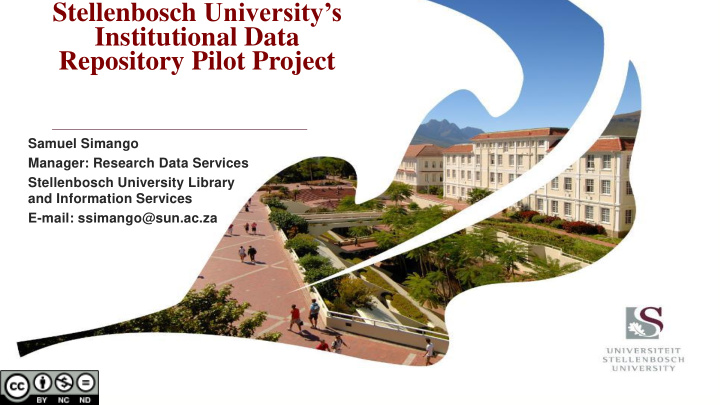



Stellenbosch University’s Institutional Data Repository Pilot Project Samuel Simango Manager: Research Data Services Stellenbosch University Library and Information Services E-mail: ssimango@sun.ac.za
Introduction • Background • Motivation – prudent assessment • Goal • Context
Research Design Project Objectives Research Data Collection Methods Sources of data Data Analysis Methodology Techniques Objective 1 Case study Direct observation Figshare staff members Grounded theory and Figshare users Semi-structured interviews Figshare staff members Documentation Figshare documentation Participant observation Figshare web-based interface Objective 2 Case study Documentation OAIS reference model Grounded theory Documentation Figshare documentation Objective 3 Case study Participant observation Figshare web-based Grounded theory interfaces Objective 4 Case study Direct observation Participating researchers Grounded theory Documentation Existing research data Participant observation SU library metadata management division Objective 5 Survey research Self-administered Participating researchers Statistical analysis questionnaire
Objective 1 - How does Figshare work? • Documentation • Components and features • Platform’s environments • Interfaces for searching, browsing and information retrieval
Objective 1 - How does Figshare work? • Home
Objective 1 - How does Figshare work? • Uploads
Objective 1 - How does Figshare work? • User account - home
Objective 1 - How does Figshare work? • User account – collaborative space
Objective 1 - How does Figshare work? • User account – publication space
Objective 1 - How does Figshare work? • Browsing, searching and information retrieval
Objective 2 - Figshare and the OAIS reference model
Objective 2 - Figshare and the OAIS reference model • Functional model – entities and sub-components • Limitations of analysis technique • Functional requirements • Unanswered question
Objective 3 – Figshare’s In Information Architecture • Information architecture framework formulated by Rosenfeld, Morville and Arango (2015): 1. Organisation System 2. Labeling System 3. Navigation System 4. Searching System
Objective 3 3 – Figshare’s In Information Architecture Components Findings • Organisation scheme and structure were largely satisfactory. 1. Organisation System • Types and variety of labels appeared to be satisfactory (when viewed in 2. Labeling System isolation). • A number of aspects could be improved upon. 3. Navigation System • When the labels were analysed in conjunction with the navigation a number of flaws were found. • Some problems with embedded, supplemental and advanced navigation. • User interface has some good features but leaves a lot to be desired. It could 4. Searching System certainly use a number of enhancements. • This is the case for the following components: (1) selection of searches (2) presentation of results and (3) the design of the search interface. • Basic search anatomy and search algorithms were not assessed.
Objective 3 3 – Figshare’s In Information Architecture • Red flags • Compliance with FAIR data sharing principles • Different methods users attempt to find information: 1. known-item seeking 2. exploratory seeking 3. exhaustive research
Objective 4 – Development of Support Services • Research data uploads • Metadata assignment Researcher 1 Researcher 2 Researcher 3 Files File 1 File 1 File 1 File 2 File 3 File 4 Number of 14 13 4 6 8 4 metadata fields completed Percentage of 64% 59% 18% 27% 36% 18% completed metadata fields
Objective 4 – Development of Support Services • Results from Metadata Management Division
Metadata assignment related to samples
Objective 5 – User experience of research participants • Feedback from research participants
Lessons learned 1. It is advisable to pilot technological infrastructure. 2. Multi-prong approach is beneficial. 3. Approach and sequence of analyses matters. 4. Extensive research should be conducted – read, read and read! 5. Functional capabilities should be assessed. 6. Governance framework is very important. 7. Technology should be assessed along with associated services. 8. Information architecture should be assessed.
List of References • Consultative Committee for Space Data System. 2012. Reference Model for an Open Archival Information System (OAIS). Accessed: https://public.ccsds.org/pubs/650x0m2.pdf [2017, September 11]. • Rosenfeld, L., Morville. P & Arango, J. 2015. Information Architecture For The Web and Beyond . Sebastopol: O’Reilly.
Acknowledgements • Stellenbosch University Library and Information Service senior management team • Stellenbosch University Library and Information Service Research Data Services working team
Dankie . Thank you Enkosi
Recommend
More recommend